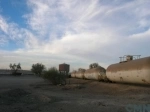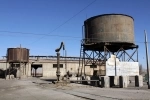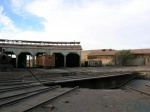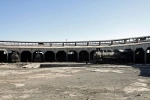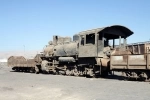Baquedano Railway Museum. Antofagasta - CHILE
Direccion:
Baquedano, Sierra Gorda, Región de Antofagasta Web:
https://museosferroviarios.wordpress.com/2010/09/03/museo-casa-de-maquinas-de-baquedano/ Located 72 kilometers northeast of Antofagasta, Baquedano village owes its fame to the rail: this is the meeting point of two railway lines built to improve the conditions of exploitation and export of nitrate.
The origin of west-east line (Antofagasta and Bolivia) began in 1866, the year of the first agreement between the Bolivian government and some private dealers, which authorized the exploitation of salt deposits, borax and other mineral substances within the territory of the former province of Cobija Bolivia.
The first years of operation of this and other agreements were difficult for individuals, as each change of government in Bolivia, the provisions relating to the area of the concession, export duties and the construction of railways, were reported or modified. The first private concessionaires, most Chileans, should form different companies to renegotiate the agreements.
Thus in 1868 he formed the "Company Explotadora Atacama Desert, which was succeeded in 1869 by the" Melbourne Clark and Co., which transferred all his rights in 1872 to a Chilean corporation, the "Company Nitrate and Ferrocarril de Antofagasta ". This was authorized in 1873 to build a railway from Antofagasta and Salar offices El Carmen, for the exclusive transport of nitrate, replacing mules and oxen used hitherto for this purpose.
The railroad arrived at Carmen Alto in 1877, at Salinas in 1879, Pampa Central High in 1882 and 1883. After the end of the Pacific War in 1884, Chile took possession of these territories, and authorized the extension of line with the direction of Bolivia. In 1885 the "Company of the Antofagasta Nitrate and Railroad" signed a contract with the Compania Minera Huanchaca "of Bolivia, to build the railway venture inside. They arrived at the crossing point Ollagüe, but given the difficulties between them, the Mining Huanchaca bought in 1887 the Chilean company all rights of the railroad, which transferred the year after the British corporation "Antofagasta and Bolivia Railway Company.
The line reached Uyuni in 1889, also built the ramp that leads to Pulacayo, the main objective Huanchaca Company, which operated the huge deposit of silver present on the site.
As for the railway line running north-south, popularly called "Longinus", its history dates back to 1889, when authorities decided to join with state railway line, several existing lines of private property in order to joining the towns of Cabildo and Iquique. Calera-Iquique The section became operational in 1916. <
In 1910, the station where they intersect the longitudinal rail of the north and Antofagasta and Bolivia was named Baquedano. The point had great movement of cargo and passenger movement generated by nitrate and mining activity in the region, in the final decades of boom.
In the former station building seen and ticketing offices of the two railway companies, each on one side. In the yards are many cars and railway equipment. Opposite is the roundhouse and turntable, built in 1916 by the State Railway Company, and which is now converted into museum. They constitute a vast semicircular building, fir wood, divided into compartments, garages, which housed the locomotives, each of which was equipped with smoke bell. The ridge of the roof of the garage has two slopes, and is traversed throughout its length by a ventilation also a gable roof. The turntable had a capacity for 16 locomotives in the complex are currently six, which are steam and whose origin is American and German. This exemplary building has been restored in 1985/86, and is currently in very good condition.
FERRONOR bought in 1950 for "Antofagasta and Bolivia Railway Company" la Maestranza, the Garage and the Power House, construction of late nineteenth century, which also form an integral part of this historical monument

